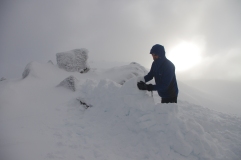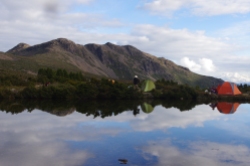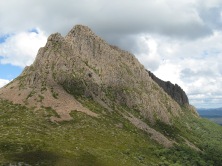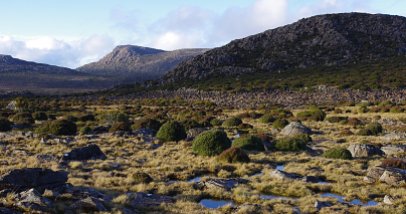It’s a perfect autumn morning in Pretty Valley. The grass and tents are frosted with ice, the air is cold and invigorating, the silence immense. Sitting and waiting for the sunlight to spread across the plains from the hills to the west, it feels so silent you can hear the earth itself humming. In the shallow valley below, white mists form above the marshy landscape and braided waterways, rising until they meet a temperature inversion, which creates a ceiling effect that stops further upward movement. The flat topped mists then flow slowly towards the south east. Finally, the sun starts to warm my back. The air fills with bird call, the parrots sweep through, chitting as they fly past. After a cold night, it seems like everyone and everything is glad to be alive this morning.
Across the mountains of south eastern Australia, climate change is already driving profound change. In many places in the high country of NSW and Victoria, snow gum forests are facing a double sided threat: dieback, caused by a native beetle is killing individual trees, and climate change driven fire regimes are devastating vast areas of forest. Climate change, drought, insects and soil microbes are all thought to contribute to dieback. The spread and impacts of the beetle appear to be super charged by climate change (more beetles are surviving because of milder winters and more mortality of water stressed trees in summer).
More frequent and intense wild fire also poses an existential threat to the survival of snow gum woodlands and forests. A new report reveals the scale of the fire impact on these forests in the Victorian high country.
In the paper ‘Long-unburnt stands of snow gum (Eucalyptus pauciflora Sieber ex Spreng) are exceedingly rare in the Victorian Alps: implications for their conservation and management’, John Morgan, Michael Shackleton and Zac Walker from the Research Centre for Applied Alpine Ecology at La Trobe University highlight that ‘Long-unburnt snow gum forests (now) comprise less than 1% of snow gum forests in the Victorian Alps. We identify where long-unburnt snow gum stands persist in the Victorian Alps and outline why management intervention is necessary to protect unburnt refuges and, more broadly, to allow mature/adult stands (such as occur on the Baw Baw Plateau) to develop into future old forests’.
Continue reading “‘Long-unburnt snow gum forests are now exceedingly rare’.”
Logging continued in many places around the country during the COVID-19 lock down. Environmental activists and locals concerned about logging operations were disciplined and largely stayed at home during the pandemic.
Now, this long wait has overflowed into action. In Tasmania, people have occupied trees in forest being cut near Mt Field. On the south coast of NSW, the community of Manyana is opposing the destruction of unburnt forest for a housing development, and now actions have happened across the Central Highlands of Victoria. This follows sustained action by locals at Big Pats Creek near Warburton.
Recently, members of Wildlife of the Central Highlands (WOTCH) observed a critically endangered Leadbeater’s Possum within an active logging coupe (480-509-0013, called ‘Desilijic’) in the Central Highlands to the east of Melbourne. Habitat just 100 metres away had already been clearfelled – well within the buffer zone triggered by this Leadbeater’s Possum detection.
Now WOTCH have heard that an interim protective buffer zone has been established surrounding the Leadbeater’s Possum detection.
Yet again, this highlights the value of citizen science in ensuring endangered species are protected.
Continue reading “Leadbeater’s Possum found in active logging site near Baw Baw”
WED April 8: As part of the shutdown to help ‘flatten the curve’ and reduce the numbers of C-19 infections, a large number of areas in the High Country are being closed over Easter and beyond.
Government advice continues to be ‘If you can stay home, you must stay home’, meaning no travel for holidays, camping, etc.
VICTORIA
In Eastern Victoria
• Alpine National Park
• Baw Baw National Park
• Howqua Hills Historic Area
• Mount Buffalo National Park
Are all closed from midnight on April 8 ‘until further notice’. Further details here.
NSW
NPWS has closed all campgrounds, camping, on-park accommodation venues and visitor centres in Kosciuszko National Park until further notice.
This includes ‘wild and backcountry camping’ in all national parks.
In line with government restrictions on non-essential travel, the following iconic attractions in Kosciuszko National Park are closed for Easter:
- The summit of Mount Kosciuszko
- Thredbo Valley track
- Kosciuszko Lookout
- Cootapatamba Lookout
ACT
All visitor facilities within the ACT Parks and Conservation Service managed estate have been closed until further notice in response to a temporary shut-down of non-essential services across the ACT.
To stop the spread of COVID-19, the following facilities are closed to maintain social distancing measures:
- Tidbinbilla Visitor Information Centre
- Namadgi Visitor Information Centre
- Woods Reserve
- All ACT public campgrounds
- All playgrounds managed by ACT Parks and Conservation Service
Tidbinbilla Nature Reserve will also be closed, along with Namadgi National Park, which remains closed due to safety reasons following the Orroral Valley bushfire
All other parks and reserves across the ACT will remain open providing the community access to nature for recreation, health and wellbeing. Park visitors must observe social distancing whilst visiting parks and reserves. This means keeping 1.5 metres from others, avoiding large groups of people, avoiding peak usage periods and practicing good hygiene always.
TASMANIA
In an effort to prevent the spread of COVID-19 and keep our community safe, the Tasmanian Parks and Wildlife Service (PWS) has closed all national parks and reserves to public recreational use.
The closure of parks and reserves was in line with Tasmanian and Federal government measures to discourage the community from undertaking non-essential travel during this time. These closures include Wellington Park.
This includes:
- National Parks
- State Reserves
- Nature Reserves
- Game Reserves
- Conservation Areas
- Nature Recreation Areas
- Regional Reserves
- Historic sites.
All activities including day or overnight walks, mountain biking, hunting, other recreational activities and camping are now closed to the public until further notice.
From the Great Forest National Park:
“There has been a little snow falling up on the Baw Baws recently. This tranquil spot called the montane fens is the headwaters of the largest water supply to Melbourne – the Thomson river. And over the next few days we’ll follow this river to your kitchen.
This relatively small stream emerges from a large soaking fen, alive with frogs and birds. But once upon a time this place wasn’t safe and was set to be logged. After a strong battle, in 2008, this unique ecosystem was finally recognised as a site of significance, named a ‘montane fen’ and logging was stopped from ring barking it’s surrounds due to the efforts of scientists and conservationists. This campaign took three years and in securing this spot we also saved the IUCN Red List of Threatened Species critically-endangered Baw Baw Frog.
We must give a big shout out to campaign and science leaders Professor Jean-Marc Hero, Dr Chris Taylor, Sarah Rees, @wilderness_aus, amphibian citizen-scientist David Black, Dr Greg Hollis and all the Zoos of Australia that backed the conservation efforts. Special thanks to folks that gathered on the steps of Parliament, signed petitions and wrote to MPs. Gratitude to Liberal ex-MP Phil Honeywood for raising it in parliament and thanks to Labor ex-MLC Gavin Jennings for delivering its final protection last year in a second conservation covenant under the Immediate Protection Areas.
You can walk the fens in a short circuit and there are some stunning picnic spots just waiting for you as soon as the lockdown is lifted”.
Photo: ChrisTaylor
https://www.facebook.com/ChrisTaylorEnviroPhotography/
You can find out more about the proposal for the Great Forest National Park here.
It’s been a hard summer for fires, both in Tasmania and the mainland mountains. In Victoria, more than 100,000 hectares were burnt in the high country, making it another season of ‘mega fire’ (these large fires are growing in frequency under the influence of climate change).
Here’s a quick look at the major areas that were burnt:
Conservation group Forest Conservation Victoria have announced that they have established a blockade of logging operations on the southern slopes of the Baw Baw Plateau. The area contains many large trees which provide critical habitat for threatened native wildlife.
Members of community group Forest Conservation Victoria have established a peaceful blockade near Mt Baw Baw in threatened species habitat which is currently being logged. A person is suspended in a tree sit 25m off the ground, preventing logging in high conservation value forest.
The area of forest marked for logging contains many large hollow-bearing trees that provide critical habitat for threatened species, such as the Greater Glider, and high levels of wildlife diversity. The Gliders, as well as a Koala, have been identified within the logging coupe by citizen scientists and this has been reported to the Department of Environment, Land Water and Planning, who have failed to respond.
Continue reading “Logging stopped near Baw Baw plateau by community blockade”
This event is organised by the Friends of Baw Baw National Park, and will be on August 13.
Volunteers from Wildlife of the Central Highlands (WOTCH) have found a koala on one of their wildlife surveys in an area on the slopes of the Baw Baw plateau where that species had not been sighted in almost two decades.
Continue reading “Koala spotted in logging coupe near Baw Baw plateau”
Long weekend in March (2 – 5 March)
Help clean up the Australian Alps Walking Track where it traverses the Baw Baw plateau. There will be a variety of work to undertake, requiring a range of skills and experience, including chainsawing, brush cutting, clearing debris, transporting equipment and fuel, clearing water bars and replacing/adding track markers.
Parks Victoria will supply all food and water, so please provide us with the days you will attend and any special dietary requirements. You will need to bring all your camping gear (tent, sleeping bag and mat etc.).
We will camp at Jeep Flat Track, a short walk from the Mt St Gwinear carpark. Remember, we will be in alpine conditions, so bring appropriate clothing.
Come for a day or stay the entire four days. To help with planning and catering please book by Thursday 16 February.
Contact: Convenor Peter Maffei, Bushwalking Tracks and Conservation, Bushwalking Victoria by email at tracks@bushwalkingvictoria.org.au or phone 0418 149 465



































































Recent Comments